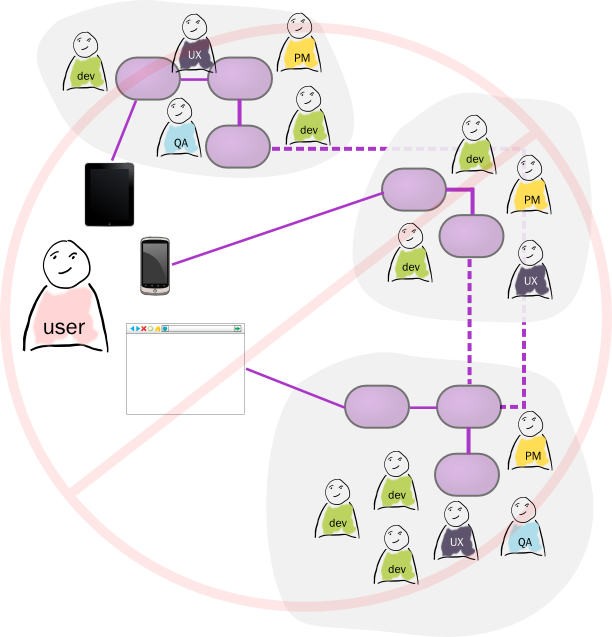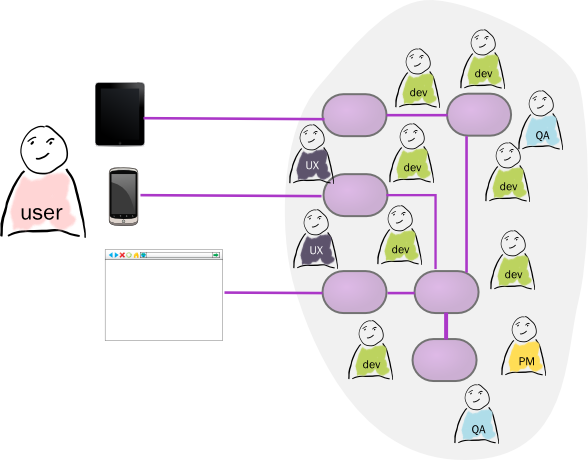Trans Media Application
1 November 2012
Mobile applications have been a hot item in software development over the past couple of years. Like many software delivery companies, Thoughtworks get a lot of requests from clients asking us to build a mobile application for them. However most of the time a company asks us (or anyone) to build a mobile application they are starting off on the wrong foot. I'd argue that for most situations, even though you want users to interact with a mobile device, you should never think of building a mobile application. Instead you need to think about building a single application that presents across multiple devices: mobile, desktop, tablet - or whatever device your users might use.

A common mistake is to think of different apps for different delivery devices.

Instead think of a single app with different presentations on different devices.
Imagine I'm using an app to find cool bars. There are many contexts in which I could use such an application:
- sitting in a coffee shop for breakfast, figuring out on my tablet where I'm going to meet my friends this evening.
- editing my photos at my desk 1 I see a picture of a really good bar I want to recommend to someone, so I access the application for information that I then email off with the photo
- it's five-thirty, I've had a long meeting, and I'm walking the streets looking for a nearby bar on my phone.
- I'm at home, with some friends, and we're exploring bar options for later on my ginormous flat screen tv.
1: A lot of people I talk to these days think the desktop is fast dying and that in time all our computer usage will be using tablets or mobiles. But I like working at a desk. When we bought our house I ensured we installed an ethernet jack on the porch so I could do my email on a laptop (this was before wireless). And for several years I'd use my laptop like this for a good chunk of time. But eventually I found it too limiting to work that way compared to the huge monitors on my desk. So while I think there's an increasing role for tablets and other devices, I still think the desktop will remain an important environment.
In these cases what I'm trying to do is interact with some notional application, but I'm doing so through very different devices in very different contexts. Despite this, however, I don't want to see these as separate applications, but as different presentations of a single application. Ideally I could swap between them even in a single context (I don't know how to find bars near me on the web site on my laptop, so it's quicker to do it the way I normally do on the phone than look up the help docs.)
That's a consumer case, but the same thinking applies for in-house applications. If I'm a retail store manager I may do some stock checking by prowling the aisles with a tablet, but do other stock management work at my desk where I have a bigger monitor and keyboard.
As usual, what counts here is the user experience, it's about how software helps the user achieve their desires better.The user just wants that “I Rule” moment. The fact that the company commissioning the software wants to send out the web site and mobile app to different software houses is less relevant than 1923's baseball scores. So the user goes elsewhere and the app provider is a victim of the shattered future.
It's as though the single screens of yesterday have been shattered and the shards have been embedded into our pockets, our environment, and the products we use.
-- Jonny LeRoy
Such transmedia thinking 2 goes beyond the common phone/web/tablet devices. Back in 2005 when Tim O'Reilly launched the Web 2.0 meme, one his patterns for the next generation of software was Software Above the Level of a Single Device. His exemplar for this was the iPod, whose success was partly due to how “This application seamlessly reaches from the handheld device to a massive web back-end, with the PC acting as a local cache and control station” The product wasn't just the iPod, it was the iPod plus iTunes combination. Todays leading exemplar might be Netflix, which is a product you habitually use in a transmedia manner - with many different devices allowing you to see your movies on a TV, including one of which involves the post office as a data transport medium.
2: The term “transmedia” comes from the concept of transmedia storytelling which is all about telling a single story that uses different media: film, comics, games etc. This is different to using different representations of the same story, such as novelizations, in that the different media are intended to be woven into a single whole. This is why I think that “transmedia” is a good term to appropriate for this kind of application. (My thanks to Kyle Hodgson for introducing me to the transmedia meme.)
This last point should remind us that transmedia thinking is in many ways just basic systems analysis. When doing analysis work for a software project, the point is to look at the overall domain process and consider how software can best support it. The transmedia label helps remind us that software can pop up in all sorts of places where we might not consider it before.
An important of part envisioning a transmedia application is that each device is used in different contexts to do different things. As a result the experience needs to designed with these contexts in mind - both in being aware of the different contexts and thinking about how they flow together. If you're looking for bar on your phone, you're much more likely to want to know nearby bars than if you're going through the website on your desk. If you're interacting with a travel management application, it should be able to tell that you're accessing via a phone, you're in your connecting airport between two flights, and thus make it easy for you to see how long you have to get to your connecting flight and how to get to the gate.
This is why I consider the desire to create a mobile application to be a Wrong Thought. It immediately frames the mobile application as something separate from the web site, as is the thinking that you're building just a web site. Instead you need to start with the user, figuring out what it is that they want to do and how software can help them do that. When thinking about this everyone needs to be thinking in a transmedia manner - and by everyone I mean all parts of the work: user experience, software architecture, project management…. The application, and the project team that builds it, need to be thought of as a single whole, all dedicated to making their users happy.
Further Reading
- Kelly Sommers (kellabyte) provides an example what a transmedia application might look like. This article also explores the notion of transmedia storytelling with some interesting links and videos.
- Joshua Topolsky coined the term Continuous Client which is a similar concept 3, Kelly Sommers also has a post with thoughts about implementing a continuous client.
- Google produced a research report on navigating the new multi-screen world, which is their thinking on the transmedia application.
- Jonny LeRoy wrote a couple of articles on surviving the shattered future, talking about the challenges in a world where users want to use different media to interact.
3: Although continuous client is clearly a very similar concept, I do see a distinction in that I can imagine applications that are designed and experienced as separate applications supporting continuous client behavior by coordinating on how they do hand-offs between each other. The result would be an effective continuous client, but not a holistic transmedia application.
Notes
1: A lot of people I talk to these days think the desktop is fast dying and that in time all our computer usage will be using tablets or mobiles. But I like working at a desk. When we bought our house I ensured we installed an ethernet jack on the porch so I could do my email on a laptop (this was before wireless). And for several years I'd use my laptop like this for a good chunk of time. But eventually I found it too limiting to work that way compared to the huge monitors on my desk. So while I think there's an increasing role for tablets and other devices, I still think the desktop will remain an important environment.
2: The term “transmedia” comes from the concept of transmedia storytelling which is all about telling a single story that uses different media: film, comics, games etc. This is different to using different representations of the same story, such as novelizations, in that the different media are intended to be woven into a single whole. This is why I think that “transmedia” is a good term to appropriate for this kind of application. (My thanks to Kyle Hodgson for introducing me to the transmedia meme.)
3: Although continuous client is clearly a very similar concept, I do see a distinction in that I can imagine applications that are designed and experienced as separate applications supporting continuous client behavior by coordinating on how they do hand-offs between each other. The result would be an effective continuous client, but not a holistic transmedia application.

